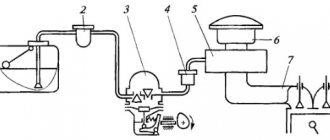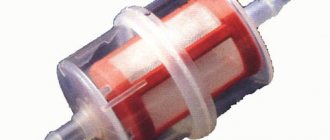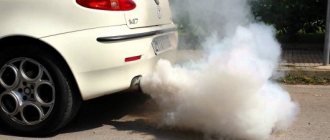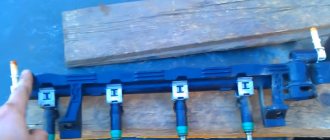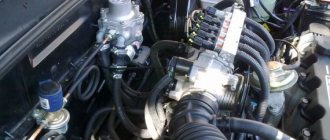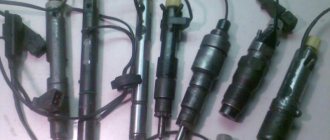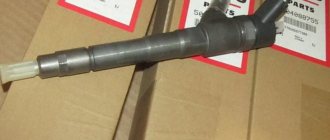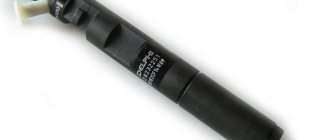Why do injectors fail?
Contaminants can enter the fuel system along with gasoline. For cleaning, filters are installed that capture contaminants larger than 20 microns. Such filters are provided both on the fuel line and in the injector itself.
Gasoline contains heavy fractions. They settle on the injector seats, and over time turn into resinous growths. This leads to deterioration of the injectors or their complete failure.
How deposits appear
When the engine stops working, light fractions of the fuel evaporate on hot surfaces. Heavy fractions settle on parts, including nozzles. There is nothing to wash them off - fuel no longer flows.
Over time, the shut-off cone can no longer fit tightly into the seat - therefore, the tightness of the nozzle is broken. This leads to interruptions when starting the engine, as the pressure in the fuel line decreases. Resinous deposits clog the injector nozzle. As a result, the amount of fuel ejected by the nozzle in each operating act decreases.
The spray pattern of the injector also changes. The sprayer has its own standards and tolerances. Solid contaminants lead to the formation of an irregularly shaped torch, fuel atomization occurs smoothly, and fuel leaks appear. Often deposits form more intensively on individual injectors, while the load on the “cleaner” ones increases.
Filter contamination
Another main reason for injector failure is dirty filters. Filters are installed along the fuel path and the injector itself has a filter. Its size is small and it is designed only to filter out very small fuel contaminants. If during operation of the fuel system the main filter, which is supposed to catch increasingly larger particles, is clogged, the injector filter instantly becomes clogged. Therefore, timely replacement of fuel system filters is the key to injector performance.
Methods for diagnosing fuel injectors of gasoline engines
A small note at the beginning. It must be remembered that a 100% accurate result can only be obtained by diagnosing the fuel injectors at a service station.
Interesting! You can also determine on your own that this element is working normally. To do this, you need to touch the working nozzle. If you feel vibration, then the mechanism is working properly.
1. Resistance measurement
How is fuel injector diagnostics carried out using this method? There is no need to remove the element, we just find out what type of injectors are used in the fuel system of your car: high impedance or low. The algorithm of actions is as follows:
- disconnect the high-voltage wiring;
- turn the ignition key, remove the negative terminal of the battery;
- disconnect the connector by unclipping the fastening clip;
- Determine the injector resistance using a multimeter.
If the injectors have high resistance, the permissible value of this parameter will be 11–17 Ohms. If the injectors have low impedance, then the readings should be in the range of 2.5–4.5 Ohms. If the obtained values are greater or less than acceptable values, it means that the element has failed.
2. Testing the injector power supply
The second way to diagnose fuel injectors is as follows: you need to test the connector contacts. Current is supplied to the injectors through four contacts located in the connector. We perform the check in pairs. Allowable resistance is 11–15 Ohms. How to determine which injector has failed? To do this, disconnect each element one by one. Using a wire, we connect the part with the electronic control unit. Then turn the ignition key. When the injector is working properly, fuel will be injected.
3. Resistance in monoinjector
It is quite rare to find internal combustion engine models that have one injector installed.
In this case, we test the connector contacts in pairs; the permissible resistance value is 1.2–1.6 Ohms.
In most cases, the monoinjector contains a starting nozzle, which supplies gasoline to the engine (before it warms up). This mechanism operates for only a couple of seconds, after which it turns off. We test it too, to do this we remove the element and place it in a measuring container, it is necessary to determine the volume of fuel injection.
Next, we connect the part to the battery: one contact to the battery, the other to ground, connect the pump relay to the positive of the battery. Then turn on the ignition, the internal combustion engine should run a full cycle. After turning off, determine the volume in the measuring container. The resulting value should not be more or less than the acceptable value. After this, wipe the element and wait 2-3 minutes to prevent leakage. If everything is in order, install the part back.
4. Listening to injectors
Some motorists use the following method for diagnosing fuel injectors - listening to the mechanism. A stethoscope is used for this. If you hear uniform clicks, then the part is in order. However, when the click intervals are broken, there are extraneous sounds, and the element needs to be cleaned or replaced.
5. Diagnostics on the ramp
We remove the ramp, remove the wiring harnesses and the negative terminal of the battery. Separately, we restore the circuit and turn on the ignition. We place measuring containers under the ramp. After the starter rotates for 10–15 seconds, a certain amount of fuel will accumulate in the tanks. It is important that each cup contains the same amount of gasoline. If the result of diagnosing fuel injectors is different, it is necessary to test the car on a special stand.
If testing has shown that the injectors are working normally, but the engine is running rough, we determine the pressure in the ramp. Most likely, the resulting figure will be below normal.
6. Injector balance
To diagnose fuel injectors using this method, you will need to install a special program on your laptop and connect it to the electronic control unit.
Then turn off the fuel pump and equalize the pressure in the system. It is important to let the motor run before you turn it off. We connect the pressure gauge to the fuel system and turn on the pump again. We turn the ignition, look at the pressure gauge readings: the permissible values are 2.8–3 atmospheres.
In the program we turn off the pump relay, now the pressure can drop to 2.5 atmospheres. Then in the program we turn on the injectors one by one and look at the pressure gauge readings. If everything is in order, pressure will be released evenly in all elements.
If the obtained indicators do not correspond to the acceptable values, this indicates that the nozzle has failed. After the diagnostics are completed, connect the pump, start the engine and only then remove the pressure gauge.
7. Diagnostics of fuel injectors on the bench
We determine whether the mechanical characteristics of the injectors correspond to the standard: pressure, volume of fuel that passes through the part, shape and angle of direction of the torch. Only at the stand you can get 100% accurate results and understand whether the elements are working properly. You can build a stand yourself, after first studying all the features of such an installation.
At service stations, diagnostics are also performed using exhaust gas toxicity parameters and a lambda probe. However, only a professional can perform such work using special equipment. The auto mechanic knows how the resulting values are deciphered.
Signs of injector failure
What are the signs that indicate that the injectors are not working properly?
- Difficulty starting the engine. If the car does not start easily after a short stop, there may be a problem with the injectors. This is the most common and obvious symptom of a malfunction of the injectors.
- Interruptions in engine operation at idle.
- The engine shakes or vibrates when accelerating or decelerating, the car moves jerkily.
- Fuel consumption has increased.
- You can hear popping noises or black smoke coming out of the exhaust pipe.
- Increased CO in exhaust gases.
- Increased temperature in the combustion chamber.
If such symptoms are observed, you should check the serviceability of the injectors. Malfunctions in their operation will negatively affect the performance of the engine and gearbox.
Why do injectors fail?
When driving, the injectors work under heavy loads, become clogged and damaged, which leads to power plant failures. Problems arise for the following reasons:
- Poor quality fuel filling. If you fill the tank with gasoline / diesel fuel with mechanical particles, foreign impurities (sulfur, paraffins) or water, expect the fuel supply to be cut off or rapid wear of metal surfaces.
- Errors during disassembly/assembly during maintenance. Violation of the technology for repairing or replacing injectors causes blocking of fuel access to the engine and the appearance of leaks.
- Resource development. Fuel automatic components work up to 75 - 300 thousand km, but with intense driving and frequent overloads, maintenance and repairs will be required earlier.
In addition, damage to mechanical/electronic injectors occurs after accidents, collisions with obstacles or heavy objects falling onto the engine compartment. Minor faults are eliminated during repairs. If the damage cannot be repaired, the fuel system parts are simply replaced with original components or analogues.
Power check
We turn off the engine. First option:
- Remove the power connector for the injector of cylinder 1.
- We connect the multimeter to the DC voltage measurement mode in the range of 0-20 Volts.
- We start the engine and observe the instrument readings. The voltage should be supplied in short pulses.
- If voltage readings appear, the wiring is OK.
- If there is no voltage coming to the power supply, then turn off the engine and call the wires, or look for damage visually.
- We connect the injector of cylinder 1 and repeat the operation with the injectors of cylinders 2-4.
Second option. Two people will be needed. We do the same thing, only turning off all the injectors at once. One person turns the engine with the starter, and the second one sequentially measures voltage pulses at the disconnected injector connectors.
Instead of a multimeter, you can use an LED.
How to check injectors without removing them from the engine
If you suddenly suspect that the injectors are faulty, you can check them without removing them from the engine.
Such an injector check will not give 100 percent accuracy. In order to more accurately diagnose the operation of injectors, you need special equipment, which not everyone has.
Checking for extraneous noise
This method requires some experience. You need to start the car and listen to whether the injectors make any unusual sounds. If you hear a distinct high-frequency noise from the area where the injectors are located, this means that cleaning needs to be done.
Checking injectors with a multimeter
The essence of this method is to measure the resistance on the injectors and compare it with the standard. Algorithm for checking resistance on injectors:
- We find out, either from technical literature or from Internet sources, what resistance is considered normal for an injector, and what the spread may be.
- We de-energize the car by removing the positive terminal from the battery
- We remove the connector from the injectors and check each one one by one with a multimeter in resistance measurement mode, comparing the resulting parameters with what they should be.
- If you find an injector whose parameters differ from the factory ones, then this is probably a faulty injector and needs to be replaced. If everything was done correctly, the problem will go away.
Checking the injector by applying voltage to it
The essence of this method is that you need to disconnect the power supply to the injector. Connect two wires in it and turn on the ignition. Next, connect these two wires to the battery terminals; if the injector begins to spray fuel, then everything is fine with it.
This is interesting: Adjusting the Lada Kalina headlights with your own hands, as well as how to remove them for replacement or repair
Checking the mechanical properties of injectors
Another method for checking injector nozzles is to diagnose mechanical properties.
Injectors have two main parameters that relate to mechanical properties. This is the amount of fuel sprayed, and the appearance of the spray pattern.
In order to check these properties, a special injector testing stand is required. The principle of operation of such a check is very simple. Each injector begins to pour fuel into its container at the same point in time. At the end of the test, it becomes clear which injector is not topping up, and which injector has an incorrect spray pattern.
This method gives the most accurate idea of which injector requires cleaning.
Electrical resistance measurement
This method allows you to check the injectors directly on the car.
- Google the model of injectors installed on your car. Using these data, we find the electrical resistance of the coils inside the nozzle. If nothing is found, no big deal.
- We turn off the engine. Remove the power connectors from the injectors.
- Take a multimeter. Switch it to the 0-200 Ohm (Ω) measurement mode.
- We measure the resistance of each injector. It must be within the passport values. If it was not possible to find out the nominal resistance, then you need to compare the injectors with each other. That is, if 3 injectors showed 10 Ohms, and one showed 20 Ohms, then it is considered faulty.
Checking injectors in DDCAR
In our service center, the price of service is calculated taking into account the real complexity of the problems and the effort/time spent on eliminating them. The equipment is operated by technicians who have at least 10 years of experience in diagnosing and restoring fuel equipment and vehicle components. Computer stands test equipment using 40 parameters.
You can get the original pump and other components for replacement or order analogues. After troubleshooting, the car owner receives a six-month warranty while maintaining factory obligations. Our car services are located in Moscow and are easily accessible along major transport routes of the city. Call and make an appointment for diagnostics.
Hearing test
This is the simplest and most accessible way. However, it requires a lot of experience, because you need to know how the working nozzle “sounds”. To listen, use a rectangular board or a stethoscope. One edge of the “device” must be applied to the nozzle being tested, the other to the ear.
If you hear only uniform clicks, the injector is working properly. If there are knocks, pops, or vibrations of varying intensity, you can definitely say that the nozzle is clogged.
Diesel test: how to check a diesel engine injector for functionality - Common Rail system
The starting event is an electrical test of the sprayer. The technique is simple: in impedance mode, the tester measures the number of Ohms at the injector terminals. The range of nominal values is specified in the operating instructions. It can be either 11...15 Ohms or 2...5 Ohms. The readings disappear - the part is scrapped.
A positive resolution on electrical testing is a reason to hold on to the fuel lines. With the engine running, the lines connecting the injectors to the fuel rail are probed. The purpose of the experiment is to search for tubes with a noticeably increased temperature and pronounced pulsations. This is evidence that the fuel supply channel in the section between the tube and the cylinder is clogged. This sprayer must be cleaned. If this does not help, then it makes sense to have it repaired or replaced.
A common problem with new heavy fuel power plants is difficult starting. The reason for this is worn out spray devices. Instead of maintaining the pressure set by the electronics, they drain a large amount of diesel fuel into the return line. There is only one way out - change. But first, it’s worth performing a ritual that describes how to check a diesel injector for functionality - don’t throw away the entire set at once.
Injector diagnostic stand
Modern service stations are always equipped with stands for diagnosing and cleaning injectors. This method involves removing the fuel rail and injectors from the vehicle. At such stands, complete diagnostics are carried out: checking the power supply, measuring electrical resistance, and checking the performance of the diagnosed injectors. Some people construct similar stands on their own.
Monitor the condition of the injectors, change fuel filters on time, refuel with high-quality fuel at trusted gas stations, undergo maintenance on time and you will not have problems with the fuel system.
Previous post Instructions CONSULT-III plus
Next entry Idle air control (IAC) - how it works, malfunctions, symptoms, check
Diagnostics of diesel engine fuel injectors in case of serious malfunctions
1. Checking diesel injectors for overflow (drain to return)
When diesel injectors wear out, fuel begins to leak back into the system. As a result, the pump stops delivering the required pressure. All this leads to the fact that starting the internal combustion engine is difficult, as is its operation.
To diagnose fuel injectors at the pharmacy, take a syringe (20 ml), as well as droppers. To connect them, you will need a tube 45 cm long. Proceed as follows to understand which of the nozzles throws more fuel into the return line than necessary:
- We take the plunger out of the syringe.
- We start the internal combustion engine. Using droppers, we connect the syringe to the return line of the nozzle; to do this, insert the tube into the neck of the syringe.
- We hold the syringe for 2-3 minutes, it should fill with fuel (if this happens at all).
- We perform this manipulation for each nozzle in turn (or make a dropper system for all elements).
Let's analyze how much fuel has accumulated in the syringe:
- There is no fuel in the syringe at all, this indicates that the injector is functioning correctly.
- The syringe contains 2-4 ml of fuel - this result is considered normal.
- There is more than 10–15 ml of fuel in the syringe, which means the nozzle is faulty, you should install a new one or repair the old element. When the syringe contains more than 20 ml, it will not be possible to restore the injector, since the injector valve seat is worn out and it does not hold fuel pressure.
Self-diagnosis of fuel injectors without the use of a hydraulic stand and test plan will not give an accurate result. The fact is that when the internal combustion engine is started, the volume of fuel discharged depends on many factors. The injector may be clogged and needs to be cleaned. The element may “freeze”, then it should be repaired or a new one installed. Therefore, by performing such testing on your own, you can only understand what the throughput of the injectors is.
When the volume of fuel passed through is the same - up to 4 ml in 2 minutes, then the injectors are working properly. The permissible value of fuel that can be supplied to the return line should be found in the operating manual of your car.
How to extend the life of injectors? To do this, use only high-quality fuel. It affects the functioning of the entire system. You should also install original fuel filters and replace them regularly.
2. Checking injectors using special instruments
To obtain accurate results after diagnosing fuel injectors, a maximeter is used. It is a model nozzle with a spring and scale. Using this device, you can set the pressure for the start of diesel fuel injection.
How else can you check the injectors? Use a control sample working nozzle. Compare the elements installed in the motor with it. Testing is carried out when the internal combustion engine is running. The sequence of actions is as follows:
- We remove the injectors, as well as the fuel line from the engine.
- We install a tee on the free fitting of the high-pressure fuel pump.
- Loosen the union nuts on the remaining fuel injection pump fittings so that fuel flows to one injector.
- We connect the control and also the tested injector to the tee.
- We turn on the decompressor mechanism.
- We rotate the crankshaft.
If everything is in order, the fuel injection results of the control and tested injectors will be identical. Noticed any deviations? Then you will have to adjust the nozzle.
We recommend
“Repairing fuel injectors: causes of malfunction, diagnostics, methods for solving the problem” Read more
To perform such diagnostics of fuel injectors, it will take more time than when using a maximeter. But the results obtained will be more accurate. In addition, you can test the functioning of the motor, injectors and fuel injection pump on an adjustment stand. To do this, you will have to contact a car service.
